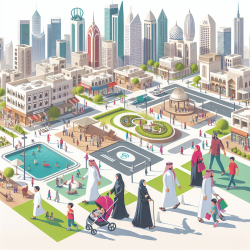The rapid urban expansion in Saudi cities has led to increased vehicular traffic and congestion, significantly impacting residents' walking conditions. Walking offers numerous health and environmental benefits, yet the willingness to walk is influenced by various factors such as accessibility, perception, and safety. This blog explores the outcomes of a study conducted in the neighborhoods of Doha and Dana in Dhahran, Saudi Arabia, and how practitioners can use these insights to improve urban walkability.
Key Findings from the Study
The study utilized Geographic Information Systems (GIS) and SPSS statistical software to analyze data collected from field observations and interviews with 200 residents. The results highlighted several crucial aspects:
- Accessibility: Community facilities are often randomly placed within districts. Mosques are the closest facility with an average accessibility distance of 242 meters, while gas stations and pharmacies are among the furthest.
- Willingness to Walk: Approximately 43% of respondents prefer daily walking. However, hot weather during summer and narrow, poorly designed sidewalks deter many from walking.
- Sidewalk Conditions: Sidewalks are frequently blocked by trees, street signals, and illegally parked vehicles, further discouraging walking.
Strategies for Improving Walkability
Urban planners and practitioners can implement several strategies to enhance walkability based on the study's findings:
- Enhance Accessibility: Ensure that essential community facilities are strategically located within walking distance for most residents. This may involve redesigning urban layouts to cluster services more effectively.
- Tackle Environmental Barriers: Address issues such as extreme weather by providing shaded walkways or indoor walking paths to encourage year-round walking.
- Improve Sidewalk Infrastructure: Redesign sidewalks to be wider and free of obstructions. Regular monitoring and enforcement can help keep pathways clear of parked vehicles.
- Create Awareness Programs: Educate residents about the benefits of walking and promote it as a healthy lifestyle choice through community programs.
The Path Forward
This study provides valuable insights into improving urban walkability in Saudi cities. However, further research is needed to explore accessibility patterns across different cities in the Kingdom. Additionally, examining the impact of climate on walking behavior and the physical conditions of residents could yield more comprehensive strategies for enhancing walkability.
Examining the Walking Accessibility, Willingness, and Travel Conditions of Residents in Saudi Cities










